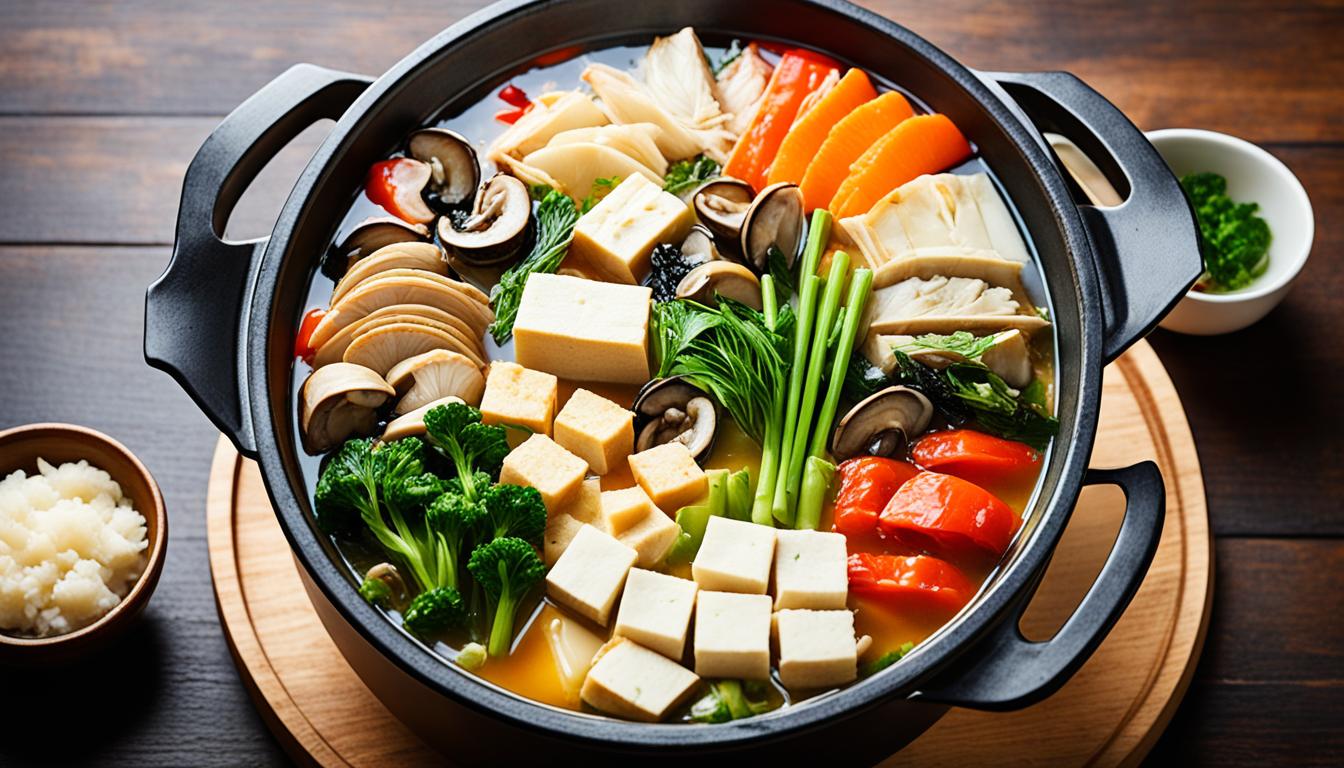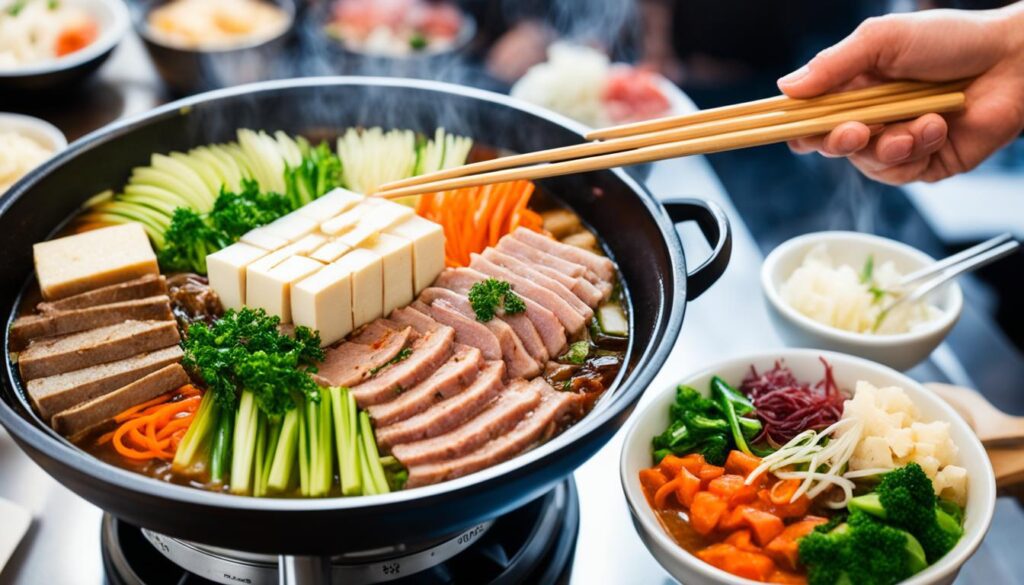
Welcome to the world of nabe, a beloved hot pot dish that brings warmth and comfort to Japanese cuisine. Nabe is more than just a meal – it’s a communal experience where friends and family gather around a steaming pot, sharing in the delicious flavors and hearty ingredients. Whether you’re a fan of traditional Japanese cuisine or simply looking to try something new, nabe is a must-try dish that will satisfy your taste buds and warm your soul.
Nabe, which means “pot” in Japanese, is a hot pot dish that features a rich and flavorful soup simmered with a variety of ingredients. It is a versatile dish that can be customized to suit individual preferences and dietary needs. From hearty vegetables like cabbage and mushrooms to succulent meats such as beef or pork, nabe offers a wide range of ingredients that can be combined to create a delicious and nutritious meal.
Pronounced “nah-beh,” this comforting dish is easy to prepare and can be enjoyed by anyone, regardless of their cooking skills. Whether you’re a beginner in the kitchen or an experienced home cook, nabe is a dish that will impress your guests and leave them craving for more.
The word “nabe” can be written in kanji as 鍋, which literally translates to “cooking pot.” This kanji character perfectly captures the essence of nabe – a dish that is cooked and enjoyed in a communal pot, symbolizing the warmth and togetherness it brings to those who share it.
Nabe holds cultural significance in Japan, especially during the colder months. It is a dish that brings people together, fosters conversation, and creates cherished memories. Whether it’s a special occasion or a cozy night at home, nabe is the epitome of Japanese hospitality and comfort.
In the upcoming sections, we will dive deeper into the meaning and grammar of nabe, explore different types of nabe dishes, provide recipes and tips for making your own homemade nabe broth. Get ready to embark on a culinary journey and discover the delicious world of nabe.
What is Nabe?
Nabe refers to a dish in Japanese cuisine where various ingredients are stewed together in a pot and shared by placing portions on individual plates. It is a communal meal that brings people together around a portable gas stove. Nabe is popular in Japan because it offers a perfect nutritional balance with vegetables, proteins, and carbs in one dish. The resulting soup from cooking the ingredients together is rich and flavorful. It is often enjoyed with rice or noodles, allowing you to savor every last bit of the delicious broth.
Oden
Oden is a classic Japanese hot pot dish that is commonly found simmering in dashi broth at convenience stores during the winter season. It is a beloved and traditional Japanese dish that has captured the hearts and palates of many. Oden is known for its slightly sweet flavor and comforting aroma, making it a go-to choice for those seeking warmth and nourishment.
The ingredients used in oden are carefully selected to create a harmonious blend of flavors and textures. Some of the common ingredients found in oden include daikon (Japanese white radish), egg, konjac, fried tofu, beef sinew skewers, hanpen (steamed fish cake), and satsuma age (deep-fried fish paste skewers). These ingredients are slow-cooked in a flavorful dashi broth that is seasoned with soy sauce, sake, and mirin. The result is a rich and savory soup that perfectly complements the tender and succulent ingredients.
Enhancing the Oden Experience
Oden can be enjoyed as is, but there are various ways to enhance its flavors and tailor it to individual preferences. Mustard and miso are popular condiments that can be added to oden to elevate its taste and add a bit of heat. The mustard provides a spicy kick, while the miso adds depth and complexity to the dish. These condiments are often served alongside oden, allowing you to customize each bite to your liking.
Oden is not only a classic Japanese dish but also a convenient option for a quick and satisfying meal. The simmering pots of oden found in convenience stores make it a popular choice among locals and visitors alike. Whether enjoyed at home or on the go, oden offers a taste of tradition and comfort that is hard to resist.
Yose Nabe
Yose nabe is a customizable nabe dish that allows you to tailor the ingredients to your taste and preferences. This regional variation of the popular Japanese hot pot dish offers a delightful culinary experience.
To make yose nabe, start by preparing a flavorful dashi broth using kombu, a type of edible kelp. This broth serves as the foundation for the dish and adds depth of flavor to the ingredients. You can enhance the broth by adding chicken, pork, or mushrooms, depending on your preference.
When it comes to the ingredients, the key is to add them in the order of their cooking time. This ensures that each ingredient is cooked to perfection. Start with root crops like carrots and potatoes, followed by tofu, and then add leafy vegetables like cabbage and spinach.
As for the seasoning, you have the freedom to experiment with different flavors. Common options include salt, soy sauce, sake, or miso. The choice of seasoning will depend on your personal taste and the regional variation you’re following.
Once all the ingredients are simmered to perfection, it’s time to savor the rich flavors of the yose nabe soup. Dip the cooked ingredients into the flavorful broth and enjoy the comforting warmth and delicious taste.
Whether you’re exploring regional variations or creating your own unique yose nabe recipe, this customizable nabe dish offers a delightful cooking experience that brings warmth and flavor to your table. Embrace the art of yose nabe and enjoy the rich culinary traditions of Japan in your own kitchen.
Sukiyaki
Sukiyaki is a delectable nabe dish that combines tender beef, fresh vegetables, and a flavorful soup known as “warishita.” This popular Japanese stew is prepared by mixing soy sauce, sugar, and sake to create a savory broth. Thinly sliced beef is briefly cooked in the warishita-filled pot, along with an assortment of vegetables and tofu. The result is a harmonious blend of sweet and salty flavors that is further enhanced by dipping the cooked ingredients into a raw egg mixture, adding richness to each bite.
Sukiyaki can be enjoyed with udon noodles or rice, which absorb the delectable flavors of the soup and provide a satisfying accompaniment to the beef and vegetable stew. The combination of succulent beef, nutritious vegetables, and the indulgent dipping sauce make sukiyaki a cherished dish in Japanese cuisine.

For those looking to recreate this flavorful dish at home, here is a simple sukiyaki recipe:
| Ingredients | Instructions |
|---|---|
| Thinly sliced beef | 1. Heat a sukiyaki pot or a large skillet over medium heat. |
| Assorted vegetables (such as napa cabbage, mushrooms, tofu, and green onions) | 2. Add the beef slices and cook until lightly browned. |
| Warishita soup (made by mixing soy sauce, sugar, and sake) | 3. Add the vegetables and tofu to the pot and pour the warishita soup over them. |
| Raw egg mixture | 4. Cover the pot and simmer for a few minutes until the vegetables are cooked to your liking. |
| 5. Serve the sukiyaki with a side of raw egg mixture for dipping and enjoy! |
Chanko Nabe
Chanko Nabe is a delicious and hearty hot pot dish that holds a special place in the hearts of sumo wrestlers. This traditional delicacy is renowned for its large quantities of ingredients, making it a rich and filling meal. The secret to its robust flavors lies in the combination of various meats, fish, and vegetables, which add depth and texture to the dish.
When preparing Chanko Nabe, you have the freedom to experiment with different seasonings and ingredients, allowing you to customize the flavors based on your personal preferences. This versatility makes Chanko Nabe a perfect choice for those looking to explore their culinary creativity and create a unique dining experience.
Whether you choose to cook Chanko Nabe at home or visit a specialized restaurant run by former sumo wrestlers, you can savor the incredible taste of this sumo wrestler food. Indulge in the large portions of ingredients and relish the rich and satisfying flavors that make Chanko Nabe a beloved dish in Japanese cuisine.
